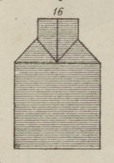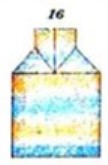| The Public Paperfolding History Project
Last updated 1/11/2023 x |
|||||||
| The Inkwell / The Tea Caddy | |||||||
| This
page attempts to record what is known about the origin
and history of the origami design known as The Inkwell.
Please contact me if you know any of this information is
incorrect or if you have any other information that
should be added. Thank you. This design is developed from the Triple Blintz Basic Form. ********** 1863 A design called 'De theebus' (the tea caddy) is illustrated in 'De Kleine Papierwerkers 1: Wat men van een stukje papier al maken kan: Het vouwen' (The Small Paperwork 1: What one can make from a piece of paper: Folding) by Elise Van Calcar, which was published by K H Schadd in Amsterdam in 1863.
********** 1873 An essentially similar design appears as 'Tintenfass' in 'Die Praxis Des Kindergartens' by August Koehler, which was published by Herman Bohlau in Weimar in 1873.
********** The same designs appear: 1875 As 'De theebus' in 'Froebels Methode' by Elise Van Calcar, which was published in 1875.
********** 1877 As 'The Inkstand', in 'Kindergarten Practice' by Mary Gurney, which is a substantially abridged version, in two parts, of 'Die Praxis Des Kindergartens' by Auguste Koehler. The second part, 'Froebel's Plane Surfaces', contains sections dealing with paper folding, cutting and weaving. The date of the first edition is not known. The second edition was published in 1877 in London by A N Myers and Co.
********** As 'Tintenfass' in part 2 'Die Praxis' of 'Theoretisches und praktisches Handbuch der Fröbelschen Erziehungslehre' by Bertha von Marentholtz-Bülow, which was published by George H Wigand in Kassel in 1887.
********** 1880 In 'Maakt de Kinderen Gelukkig' by Elise Van Calcar, which was published by H C Van Calcar in Gravenhage in 1880, there is reference to this design as 'de theebus', although no illustration is provided. ********** |
|||||||




